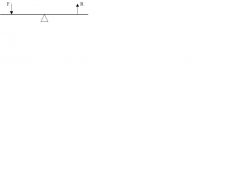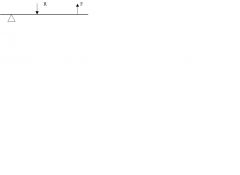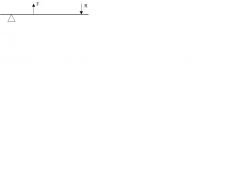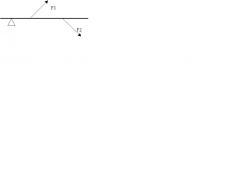![]()
![]()
![]()
Use LEFT and RIGHT arrow keys to navigate between flashcards;
Use UP and DOWN arrow keys to flip the card;
H to show hint;
A reads text to speech;
42 Cards in this Set
- Front
- Back
|
TORQUE
|
- The turning effect produced by a force
T(torque) = [Force X Moment arm(r)] |
|
|
MOMENT ARM
|
It is the perpendicular distance from the line of action of the force to the axis
Ex: Opening a door, seesaw, levers |
|
|
LEVER
|
- a simple machine consisting of a relatively rigid bar-like body that may be made to rotate about an axis (fulcrum).
- Used to gain mechanical advantage |
|
|
PARTS OF A LEVER
|
1. applied force
2. resistance 3. axis of rotation |
|
|
1st CLASS LEVER
|

- applied force and resistance on opposite sides of axis
- Ex: pliers, nutcrackers, lifting with shovel |
|
|
2nd Class Lever
|

- Resistance between applied force and fulcrum
- Ex: nutcracker, wheelbarrow (wheel is the axis, resistance is the load) |
|
|
3rd CLASS LEVER
|

- applied force between fulcrum and resistance
Ex: - Rowing - hand at top is the axis - hand closer to the paddle is the force - Baseball Bat - bottom hand is the axis - upper hand is the force - Resistance is when the ball hits the bat |
|
|
The resultant will be in the direction of F2 because its further from the axis.
|

In what direction will the resultant go if both forces are equal?
|
|
|
DOOR
|
- axis of rotation is the hinges
- The farther away from axis of rotation the greater the force and torque. - When the arm is perpendicular to the door it will give the greatest force. - If the arm is oblique to the door it will decrease the angle of the moment arm and will decrease torque |
|
|
SEE SAW
|
- The greater the weight the closer to the axis that the person would want to move
|
|
|
Joey weighs 200N and sits 1.5m from the axis. Susie weighs 190N and sits 1.6m from the axis. Who has the greatest torque?
|
Susie's Torque = (190N)(1.6m) - (200N)(1.5m) = 4 Nm
- The answer is positive so it will go in the positive direction which is Susie's side. Therefore, Susie has a greater torque. + = ccw - = cw |
|
|
EQUILIBRIUM
|
- For an object to be in static equilibrium, the external forces must sum to zero and the external torques (about any axis) must sum to zero as well.
Sum of F = 0 Sum of T = 0 |
|
|
CENTER OF MASS
|
- point at which body's mass is equally distributed in all directions
|
|
|
CENTER OF GRAVITY
|
- point at which body's weight is equally balanced in all directions
Sum of T = 0 - Males have a higher center of gravity - change in CG depends on the relative masses of the segments and the magnitude of their displacements. |
|
|
BASE OF SUPPORT
|
- area bound by the outermost regions of contact between a body and support surface or surfaces.
|
|
|
LOCATION OF BODY'S CENTER OF GRAVITY
|
Standing Upright = chest
One arm raised in a horizontal position = towards the arm that is raised Both arms are raised to the side in the same horizontal plane = the center of gravity doesn't move One arm is raised vertically over the head = CG goes up Both arms are raised vertically over the head = CG goes up even further |
|
|
2 FACTORS THAT DETERMINE THE DIRECTION AND HOW FAR THE CG MOVES
|
- magnitude of force
- displacement |
|
|
3 PEOPLE, ALL THE SAME HEIGHT, HAVE DIFFERENT CG LOCATIONS: 52%, 55%, AND 58%. WHAT DOES THAT TELL YOU ABOUT THEIR RELATIVE BODY STATURES
|
There body weight is distributed differently
|
|
|
STABILITY
|
- the capacity of an object to return to its original position (eqilibrium) after being displaced
- The stability of an object is affected by the height of CG, the size of the base of support, and the weight of the object. |
|
|
WHY SHOULD YOU FLEX BOTH KNEES AND HIPS WHEN LIFTING A HEAVY OBJECT OFF THE FLOOR?
|
- If you only flex hips you move your head out and become unstable.
|
|
|
WHAT IS THE BEST BODY POSITION IN A TUG OF WAR?
|
- base of support is spread
|
|
|
WHY IS A ONE-HANDED DUNK EASIER THAN A TWO-HANDED DUNK?
|
- you can get higher
|
|
|
WHY DO MANY WRESTLERS PREFER TO START FROM THE BOTTOM POSITION?
|
- Their center of gravity is lower so it is easier to move the person standing.
|
|
|
ANGULAR POSITION
|
- the orientation of a line with another line or plane
|
|
|
ABSOLUTE ANGULAR POSITION
|
- when the other line or plane is fixed and immovable relative to the earth
- Ex: arm flexion relative to the horizontal plane |
|
|
RELATIVE ANGULAR POSITION
|
- The plane of reference isn't fixed
- Ex: forearm flexion relative to the upper arm which can change position on a regular basis. |
|
|
ANGULAR DISPLACEMENT
|
- the angle formed between the final and initial positions of a rotating line.
- Right hand rule: when fingers go ccw than its in the + angular direction. |
|
|
AVERAGE ANGULAR VELOCITY
|
- the rate of change of angular displacement
- increase radius than increase velocity |
|
|
INSTANTANEOUS ANGULAR VELOCITY
|
- an indicator of how fast something is spinning at a specific instant in time.
|
|
|
AVERAGE ANGULAR ACCELERATION
|
- the rate of change of angular velocity
|
|
|
INSTANTANEOUS ANGULAR ACCELERATION
|
- angular acceleration at a specific instant in time.
|
|
|
AVERAGE LINEAR SPEED vs. AVERAGE ANGULAR VELOCITY
|
- the average linear speed of a point on a rotating object is equal to the average angular velocity of the object times the radius.
|
|
|
CENTRIPETAL ACCELERATION
|
- the linear acceleration directed toward the axis of rotation (rotation).
- it is directly proportional to the square of the tangential linear velocity and the square of the angular velocity. - centrifugal force pushes you away and centripetal force will bring you back in. They are equal and opposite. |
|
|
CENTRIPETAL ACCELERATION vs. ANGULAR VELOCITY
|
- with angular velocity held constant, centripetal acceleration is directly proportional to the radius of rotation.
|
|
|
CENTRIPETAL ACCELERATION vs. TANGENTIAL LINEAR VELOCITY
|
- with tangential linear velocity held constant, it is inversely proportional to the radius of rotation.
|
|
|
ANGULAR INERTIA
|
- the property of an object to resist changes in angular motion.
- less mass therefore less inertia - an object has only one linear inertia (mass) but can have more than one angle of inertia because it has multiple axes of rotation. |
|
|
MOMENT OF INERTIA
|
- the quantity of angular inertia
- mass X k^2 - k is the distance the mass is from the axis of rotation |
|
|
PRINCIPAL AXES
|
- if an object is not symmetrical about all axes, it will have 2 pricipal axes of rotation, one where the moment of inertia is largest, and one where it is smallest- these principal axes will be perpendicular to each other.
- Ex: a runner flexes the knee and hip of the recovery leg to reduce the moment of inertia of the leg about the hip. - Longitudinal axis has the least inertia - Sagittal (anterior/posterior) has the greatest inertia. |
|
|
ANGULAR MOMENTUM
|
- moment of inertia times angular velocity
|
|
|
FIRST LAW OF ANGULAR INTERPRETATION
|
- a body continues in a state of rest, or of uniform motion in a straight line, unless changed by forces acting upon it
- angular momentum remains constant unless an external torque is exerted on it. - Ex: figure skaters abduct (spread out mass around axis of rotation) the arms to slow the spin, and adduct to speed up the spin. |
|
|
SECOND LAW OF ANGULAR INTERPRETATION
|
- if an external force is exerted on an object, the object will accelerate in the direction of the force, and the acceleration will be directly proportional to the force and inversely proportional to the mass of the object.
- the change in angular momentum of an object is directly proportional to, and in the same direction as, the external torque exerted on it. |
|
|
THIRD LAW OF ANGULAR INTERPRETATION
|
- for every action there is an equal and opposite reaction
- For every torque exerted by one object on another, the other object exerts an equal torque back on the first in the opposite direction. - Ex: tightrope walker uses a long pole to lower the center of gravity to increase inertia. |

